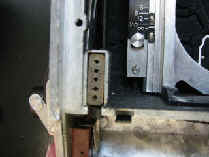
by Jo Lommen

1913-97
source:
Society for imaging science and technology :
1968 Senior Membership.
1958 Fellowship.
We probably all know the Kalart Range finder, the Kalart Focuspot, the Kalart Flash and even some of us,
the real connoisseurs, will know the Sistogun, but you never might have
heard of the Kalart Press Camera.
You won't find them as often as the Graflex, Burke & James or Busch Press Cameras.
This very over engineered 3 1/4 x 4 1/4 press camera was designed by
Chief engineer Ed Kaprelian, who joined the company after WWII.
During war time
Edward K. Kaprelian was head of the Signal Corp Photo Lab in Fort Monmouth New Jersey and after the war he joined the Kalart company
as chief engineer and contributed to the production and planning of the Kalart camera.
The
Kalart company (Stamford CT) manufactured this camera from 1948 up till 1953.
It is a remarkable and hard to handle camera equipped with a dual range finder, to allow use for left
and right eye and a electric shutter control.

No more blanks, no more double exposures.
The camera that can't go wrong
The camera came into my possession without a manual, so I had to find out the working by myself.
I started by removing the front side by the four screws inside the
housing and surprisingly, I suddenly had two parts of the camera in my hand.
The front and the back. The back held the bellows, which I removed by its four screws .
Now I could see the three copper
contacts , connecting the bellows with the back side, two on the right side and one on the left.
The front of the housing holds the hinged drop bed and on top of it, you can find the ingenious range
finder which covers two view finders and the focus spot light.
No wonder you can find here a lot of wiring, mirrors, connectors and other stuff.
The power is delivered from three 1,5 volt batteries,
in the battery holder beneath the 3 1/4 x 4 1/4 film holder back with ground glass and viewing hood, including a hinged magnifier for fine focusing!
On the battery door it reads; "Kalart Test
Camera on loan to Mr. Willard Jones." If anyone happens to know Mr. Willard Jones, please contact me, I'm desperately curious who that might be and why he was selected to test this camera.
May be
he was a famous Photographer. Never the less, this camera is completely "fool proof."
Thanks to an ingenious designed electric circuit in combination with an even more ingeniously designed
film holder, it is practically impossible to make blanks or double exposures.
The only thing that might disturb your admiration for this camera is the ingenious focusing!
However, It has to be said, that it works fantastic, once you know how to use it.

Probably the first camera wiring diagram ever been published

The picture above shows the
Kalart Camera electric wiring diagram.
To find out how the electric "brain" works I had to dismantle the camera to find out how the electric shutter
circuit works.
On the lens board there is a tiny switch. If the shutter not has been cocked, the circuit is
interrupted !
Nor can the shutter be fired without the circuit has been closed by the film
holder. The last switch is withdrawing the dark slide!
After exposure, one cannot push the dark slide back again, without turning it upside down.
The switch on the back prevents false procedure. Neither is it possible to draw the dark slide out again
to prevent double exposure.
Very ingenious.
.
Mini switch interrupting the circuit after "shooting."

Picture on the right shows the three copper connectors on the below allowing to remove the bellows without having trouble with wiring.
Once the bellows are replaced,
they make automatically connection to the similar contacts on the body thus avoiding damage to vulnerable wiring.
How they managed to bring the wiring from the back to the front, is a mystery to me.



1) Male and female connectors make it easy to separate and replace the two body parts without any problem.
Almost a modern computer slot!
2) These connections are very solid and guarantee the good working of the electric circuit.
3) The "magic" dark slide.
The upper edge is round and the lower edge is square , beside that there is a notch on the long side.
The chrome grip says that the dark slide has not been pulled out yet, so the film has not been exposed.
On the other side the grip is black, telling us that the film has been exposed.
The dark slide cannot be pulled out again. The dark slide is part of the camera’s security knock out system.

The 3 1/4 x 4 1/4 special Kalart film holder. Once the dark slide is drawn, A special construction prohibits that it can be drawn again.
The interior from the Kalart Sheet Film Holder.
By pushing the lock towards the
centre, the holder with the sheet film can be taken out of the red coloured Holder.
After loading again, don't forget
to turn the dark slide "chrome up"
It took twelve long years of research , development, experimentation and breakdown tests to get this precision instrument available to the professional photographer.
The first camera with an
electric circuit that prevents blank or double exposures.
The concept was to incorporate all the improvements of the previous inventions in one camera, to minimise the mechanical worries, guard
against human error and for all leave the photographer free to concentrate on the subject.
The Kalart focusing mystery
Back to Kalart pages